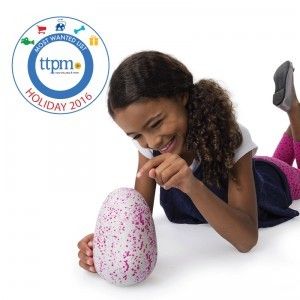Oh, dear!
A toy has disappointed some children. And the world is coming to an end. At least that’s how the tweets and social media seems to be playing it. Worse yet, the toy is swearing!!!
By now, you may have heard of the great Hatchimals disaster of 2016. After many parents stood in line and tried to get these, some of the toys apparently didn’t work correctly, and, boy, are folks angry. They clogged the Spin Master switchboards on Christmas Day, which probably were not heavily attended.
This is a shame, as no one wants a disappointed child on Christmas, especially if you’ve jumped through hoops to make a wish come true. Yet these things happen, and as I wrote last week, if your holiday is ruined because you couldn’t get a toy or because the toy didn’t function, it’s time to take a deeper look at how you’re thinking about the holidays or what expectations you’re creating for your children.
At this writing, we don’t know how many toys were affected, but complaints on social media going viral and picked up by mainstream media makes the problem seem enormous. Ironically, many of the complaints I’ve read were that the Hatchimals took too long to hatch, but the whole idea behind the play is that the child is supposed to nurture the egg by rubbing and holding it. The instructions even say it will take 20-30 minutes for the egg to begin to hatch. It’s also recommended that you replace the batteries once the Hatchimals emerge, which some people evidently didn’t do, based on their posts. At TTPM, we covered all of this in our review. By the way, my very first job in the toy industry was writing instructions, and for many products, most of our customer service calls were resolved when people followed the instructions. Unbelievable, right?

Hatchimals don’t speak English...for good reason.
As for the swearing, I can guarantee you that’s not true for one very simple reason. It would cost too much. Now, I know that sounds waggish, but hear me out. Hatchimals make sounds, but they really are nonsense sounds. Why? Well, Spin Master wants to sell these around the world, and if it said anything in English, it would have to be translated into every other language, so as with many other of these pets, they speak gibberish. So, if you’re hearing something negative, most likely, sorry to say, it’s your imagination.
But this isn’t the first time we’ve been here, though it’s easy to forget. (And aren’t you glad you have me to remind you.) Here are just a few other examples of things that went wrong.
PF Flyers...In the 1960s, these sneakers were advertised with the tagline: “They make you run faster and jump higher.” Many kids demanded them, only to be disappointed that this wasn’t, in fact, the case. The good thing that came out of this was that truth in advertising, particularly to children, in the 1970s and beyond meant that unrealistic promises couldn’t be made in kids’ advertising.
Winky Dink and You...In the late 1950s, this TV show required that kids purchase a “Magic Screen” to help the character on his adventures. It was a piece of vinyl that stuck to the screen and came with a couple of crayons. Costing a fairly substantial 50 cents and arriving by mail, kids filled in lines directly on the TV screen to “help” Winky Dink on his adventures. In addition to being disappointed by the lack of “magic” in the screen, kids without it, drew directly on the TV, which parents didn’t like at all.
Tamagotchi...In 1996, the first virtual pet took the world by storm. Problem was that if it wasn’t nurtured continually, it died. Usually in a pile of its own droppings. When the toys were banned from schools, anxious children demanded that parents care for the critters during the day. Some parents tried to comply, but outrage ensued.
Shout Elmo...In 2005, Elmo mania was still going strong. From Tickles to Chicken Dances and so forth, each year brought another highly successful toy. This particular toy took the classic Isley Brothers song, “Shout” (also a preschool staple by this time) and ran it through Elmo. They lyrics in the toy were, “Be like Elmo, and shout!” Some people thought it was saying, “Beat up Elmo and shout!” Outrage was quick to follow and it was a two-day story.
Furby...Yes, even the classic fad toy of 1998 was surrounded by controversy. Furby started out speaking “Furbish,” but it was programmed to speak more English, the more it was played with. Parents became concerned that children could teach it bad words. Even the national security agency banned Furby because they believed it people had the toy in their offices, it would hear and repeat classified information. Some even said it was a spy sent by the Chinese.
Hello Barbie...Just a year ago, this Barbie doll that could connect to a closed database was decried as a threat to kids. It would listen to them and then talk to them in ways that could be harmful. Newsweek called it “risky.” Ironically, the toy collected less identifiable data than Siri, which kids regularly play with on their own or parents’ iPhones.
As for the Hatchimals, as I said, no one wants to see a kid disappointed, though it’s hard to believe that parents are so in thrall to some inert plastic, a computer chip and fake fur to allow their holiday to be “ruined” by a toy. Yes, emotions do run high at the holidays, but let’s try to keep things in perspective, and especially when we’re thinking about “dangers,” leave the imagination to the play experience.
